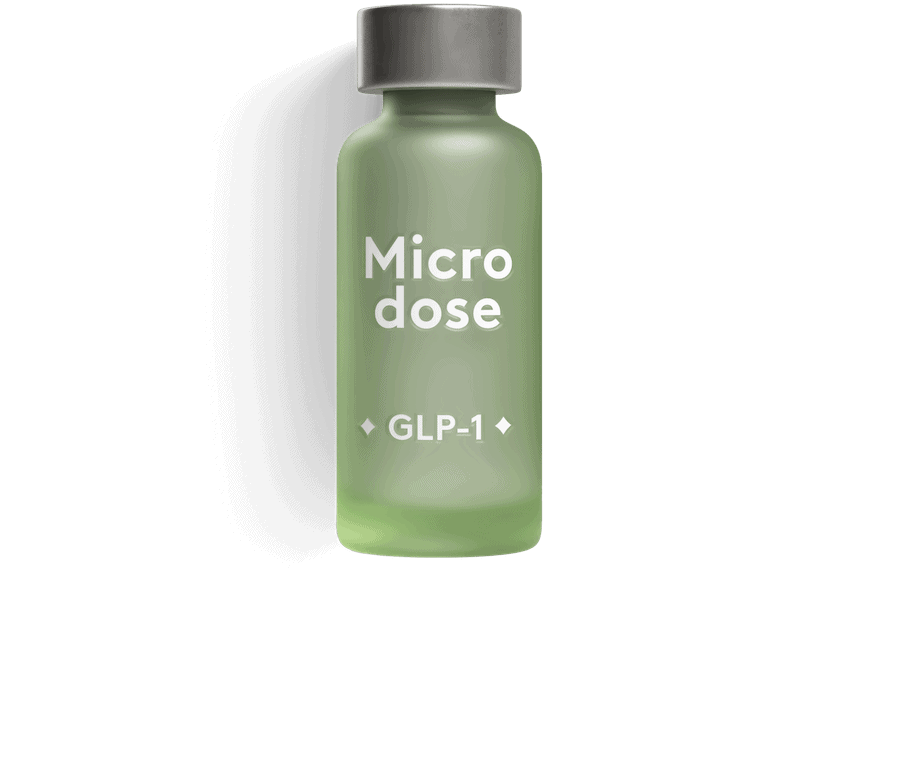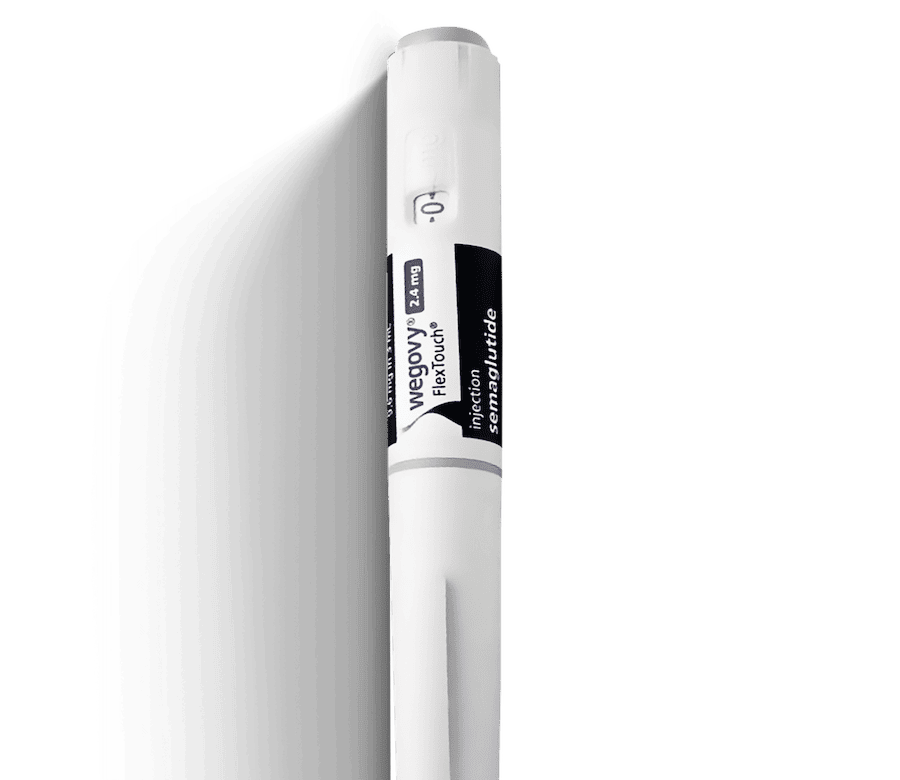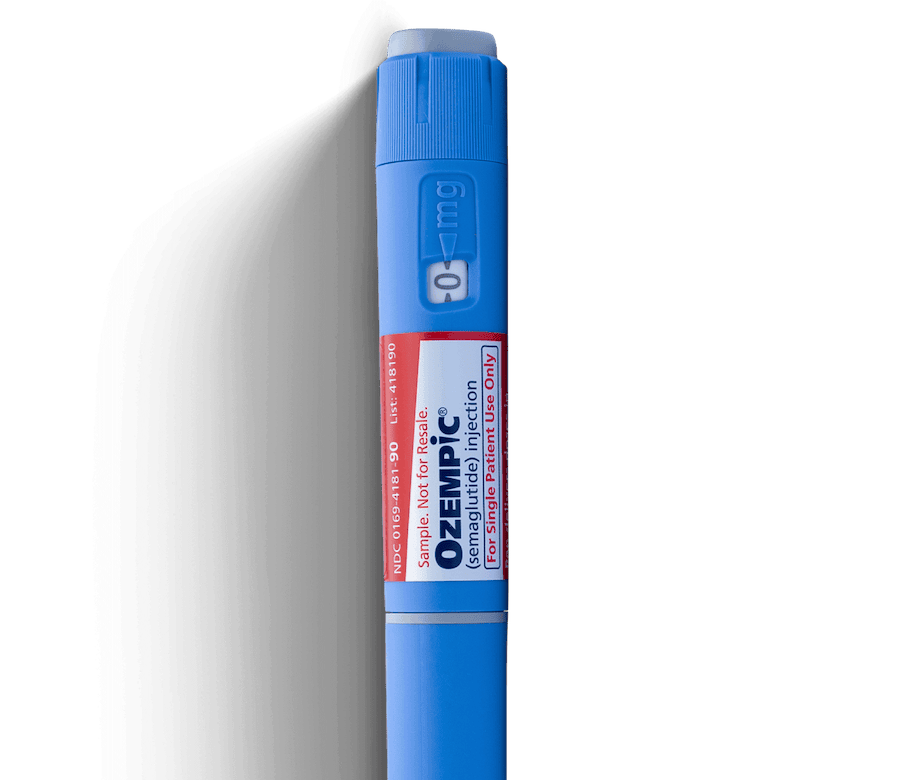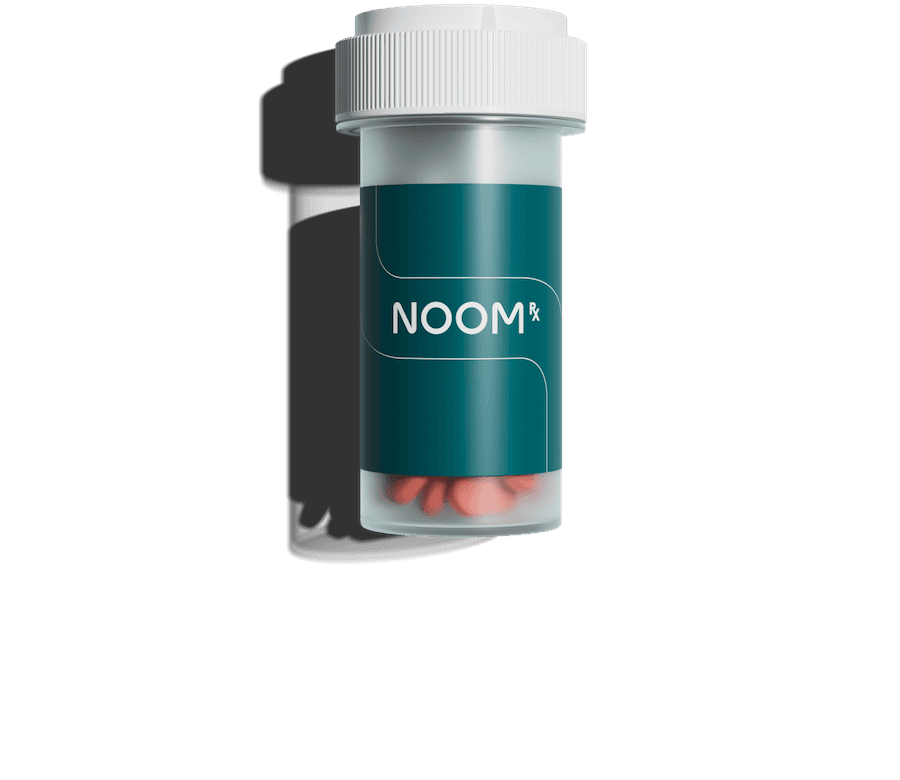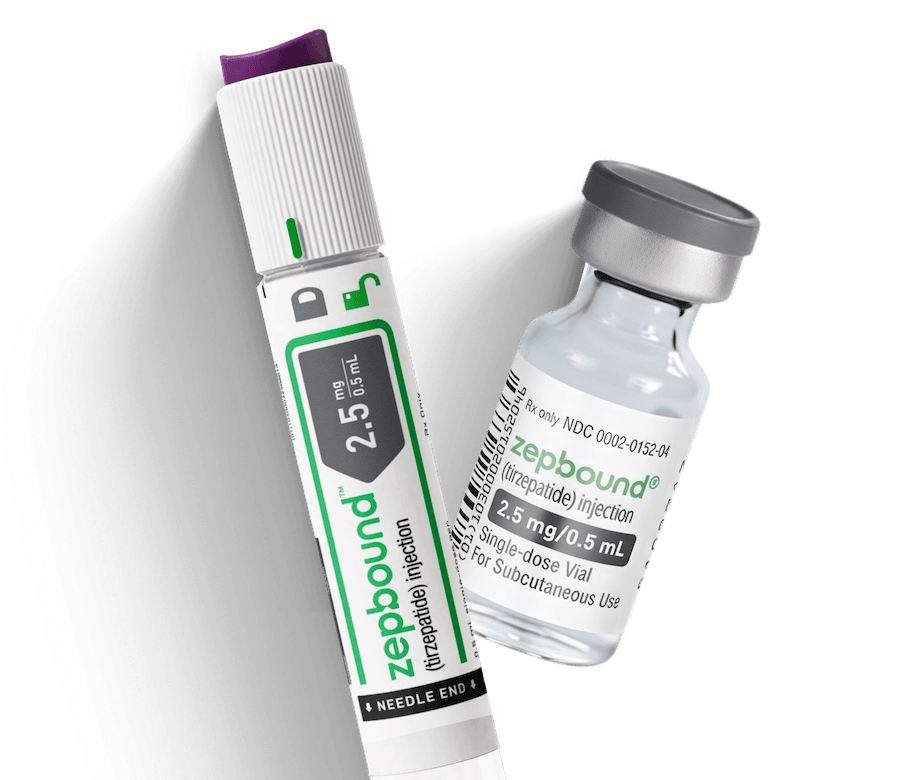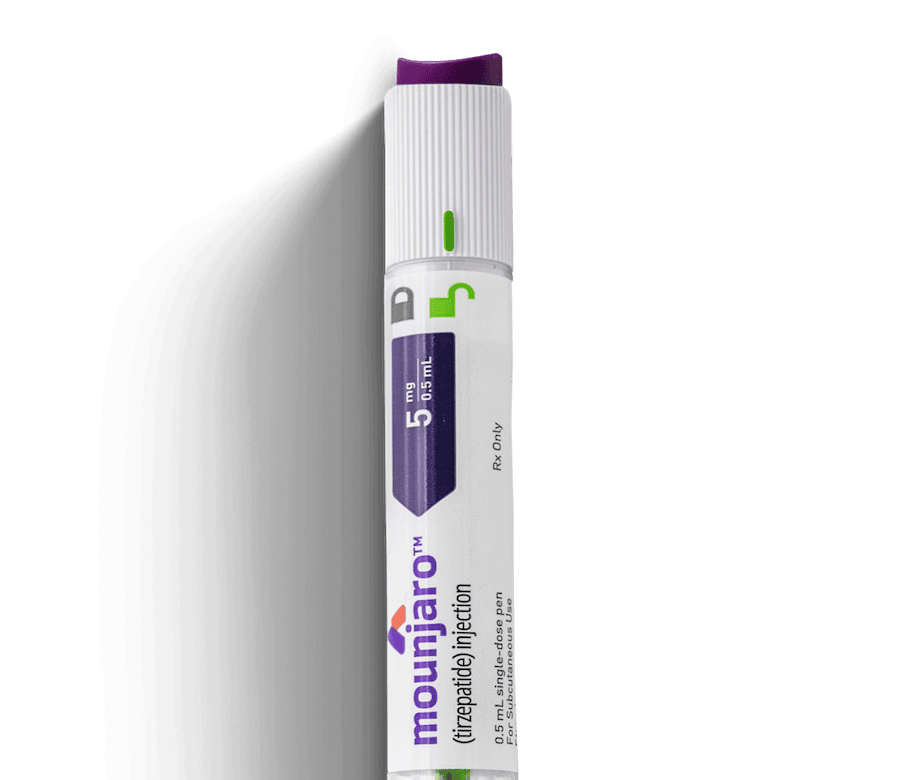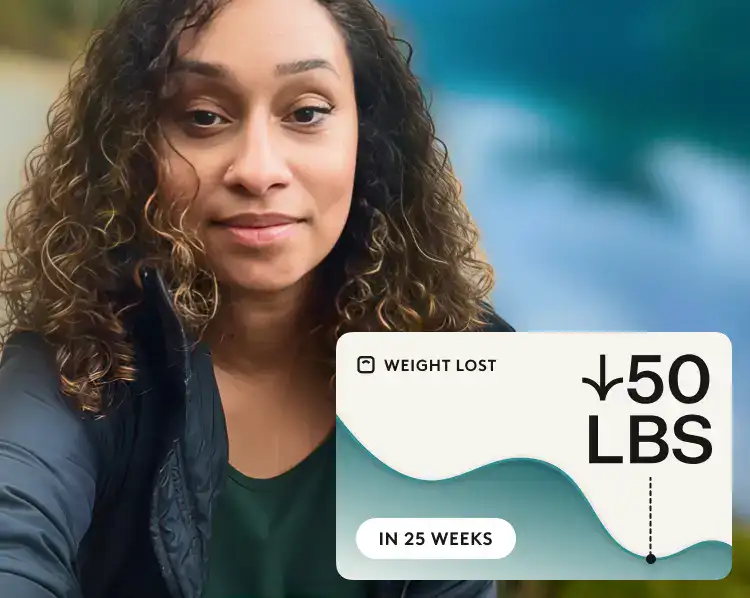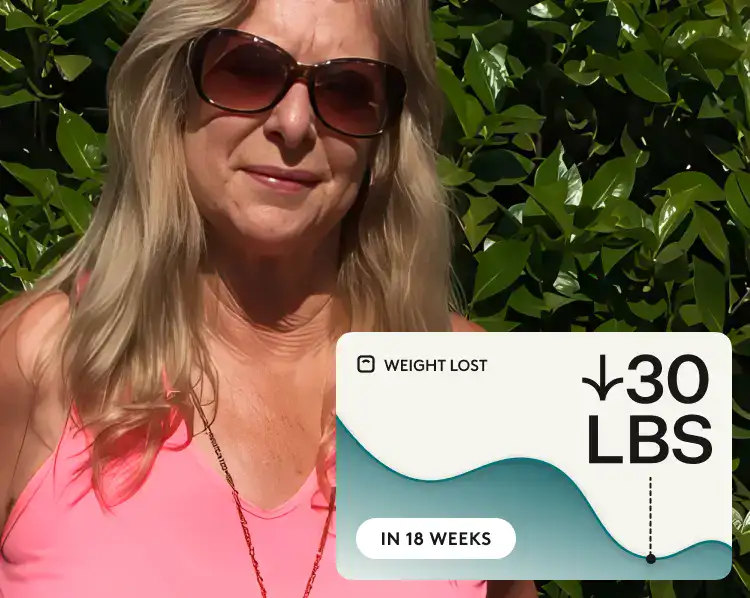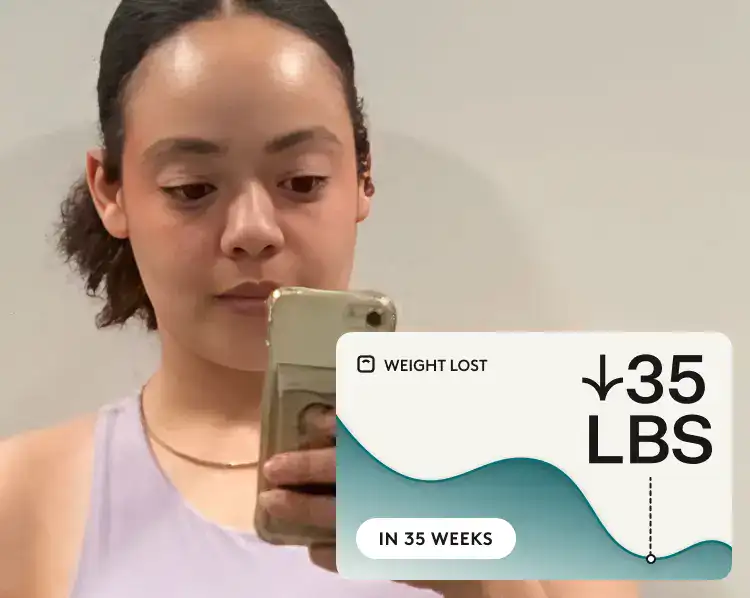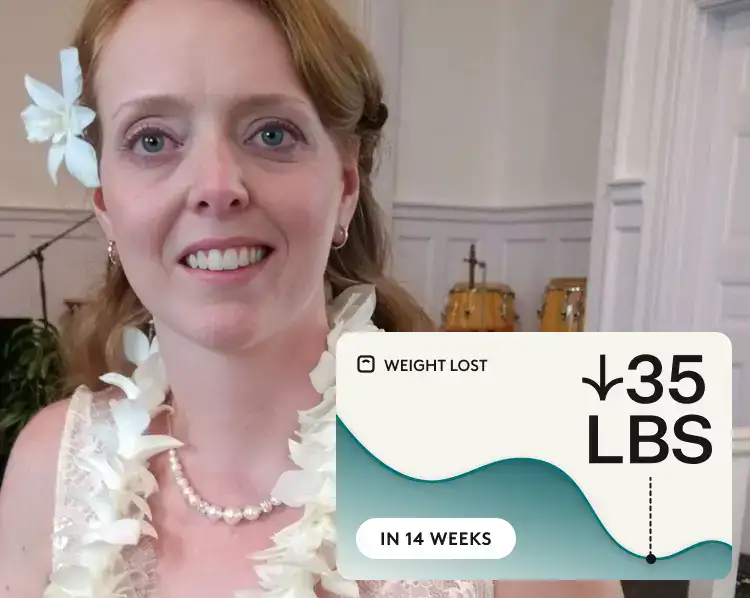What you’ll learn:
- Zepbound® is a once-weekly injectable medication that is approved for weight loss and the treatment of obstructive sleep apnea.
- Its active ingredient, tirzepatide, targets two hormones, GLP-1 and GIP, to lower appetite, slow digestion, and regulate blood sugar.
- Zepbound® is highly effective, with studies showing people can lose an average of 21% of their starting weight at the highest doses.
Zepbound® is one of the most effective weight loss medications available today, but to understand how it came to be, it helps to look at the history behind GLP-1 medications. These medications changed how people think about weight loss.
It began when people taking Ozempic®, a semaglutide-based medication approved in 2017 for type 2 diabetes, noticed something unexpected: along with improved blood sugar control, they were losing a significant amount of weight. Doctors began prescribing it off-label for weight loss, which eventually led to the FDA approval of Wegovy® in 2021, specifically for weight management.
This discovery sparked a wave of research into medications that work on the same hormone pathways. Tirzepatide, the active ingredient in Zepbound®, came from that next step in development. It works a bit differently from semaglutide. Like semaglutide, it mimics GLP-1, but it also activates GIP receptors. Targeting both hormone receptors extends appetite suppression, enhances fat metabolism, and helps regulate blood sugar in a more pronounced way.
Both Mounjaro®, approved in 2022 for type 2 diabetes, and Zepbound®, approved in 2023 for weight loss, contain tirzepatide.
Ready to see what sets Zepbound® apart? Let’s take a closer look at how it works, typical weight loss results, cost considerations, side effects, and how to know whether it could be a good fit for you.
What is Zepbound® and how does it work?
Zepbound® works by mimicking two hormones your body produces: GLP-1 and GIP. These hormones are released when you eat and help coordinate signals between your gut, brain, and pancreas to lower appetite, slow digestion, and regulate blood sugar. By mimicking both hormones at the same time, Zepbound® strengthens these signals.
Let’s take a look at how it works:
- GLP-1 (glucagon-like peptide-1) is made in the small intestine. There are GLP-1 receptors in your stomach, brain, and pancreas that respond to this hormone, lowering appetite, slowing digestion, and regulating blood sugar. Zepbound® works by acting like GLP-1, attaching to these receptors to make those signals stronger and longer-lasting.
- GIP (glucose-dependent insulinotropic polypeptide) is another hormone made in the small intestine and is released when you eat fats or carbohydrates. GIP helps your body use insulin more effectively to keep blood sugar steady, and it also affects how your body stores and uses fat for energy. When GIP and GLP-1 signals are active together, appetite can decrease even further.
What’s the difference between Zepbound® and Mounjaro®?
Zepbound® and Mounjaro® have a lot in common. They’re both made by the same company, Eli Lilly, with the same active ingredient, tirzepatide. They even come in the same dose options. But they’re approved for different reasons, which changes how they’re prescribed, who they’re usually prescribed for, and what insurance might cover. Let’s take a look at some of the differences:
- Zepbound® is FDA-approved to help with weight loss in people who have a BMI of 30 or higher, or 27 or higher with a weight-related medical condition, like high blood pressure or high cholesterol. It can also be prescribed for obstructive sleep apnea (OSA). You take it as a once-a-week injection using a prefilled pen or in a more affordable vial and syringe form that you can get through the manufacturer’s Lilly Direct program. We’ll go through the exact costs below.
- Mounjaro® is approved to treat type 2 diabetes, but it’s sometimes prescribed off-label for weight loss. Remember, it has the same active ingredient as Zepbound® in the same doses. It’s also taken once a week with a prefilled injection pen. It doesn’t come in the vial and syringe format like Zepbound®.
Learn more: Zepbound® vs. Mounjaro® for weight loss
How much weight can I lose taking Zepbound®?
Zepbound® often leads to pretty significant weight loss over time, especially when you also focus on eating healthy and exercising regularly.
In studies lasting a little over a year, people taking the highest dose (15 mg) lost an average 21% of their starting body weight. Even at lower doses, participants saw consistent, gradual progress that built over time.
Let’s take a look at what the research shows about how much people tend to lose with each dose over 72 weeks:
- 2.5 mg: This is the starting dose, and most people start by taking it for 4 weeks to help their bodies adjust and minimize side effects.
- 5 mg: This dose is the next step up and usually more weight loss is seen than with the starting dose, with people achieving about 15% average weight loss if they were to stay on this dose for the full 72 weeks.
- 10 mg: This is considered a moderate-high dose, and people taking 10 mg are able to lose an average of 20% of their body weight over 72 weeks. 89% of people lost at least 5% of their body weight at this dose.
- 15 mg: This is currently the highest dose you can take, and people taking this dose achieved an average weight loss of 21%. 91% of people lost at least 5% of their body weight.
Note that while this study focused only on the 2.5 mg, 5 mg, 10 mg, and 15 mg doses, there are also two other intermediate doses: 7.5 mg and 12.5 mg. This means that there are even more options to customize your experience and find the exact dose you need to lose weight without having too many side effects.
The amount of weight you could lose will depend on your starting BMI. The people in the study above mostly had a BMI of 30 or higher when starting the medication. For the best long-term results, following a healthy, lower-calorie meal plan and exercising regularly are also really important.
Learn more: Zepbound® dosage guide: How to find the right dose for weight loss.
How quickly will I lose weight with Zepbound®?
Weight loss with Zepbound® happens gradually as your dose increases and your body adjusts. You’ll start at a low dose to minimize side effects, with higher doses leading to greater results—especially when paired with healthy eating and regular exercise.
- First few weeks: Appetite decreases, and you may lose a few pounds as your body adjusts.
- 1 to 3 months: Weight loss becomes more noticeable, and cravings are easier to manage.
- 6 months to 1 year +: Most people see major results, with an average of 15 to 21% body weight loss at higher doses, most often after at least a year or more on the medication.
Rx weight loss, the right way, with Noom
Get access to prescription weight loss medication with Noom.How to take Zepbound®: Dosage and personalization
You take Zepbound® by giving yourself an injection under the skin (subcutaneously) once per week. You can get it as either prefilled pens or single-dose vials. (Vials are cheaper if you don’t have insurance coverage, and are sold directly through Eli Lilly.)
Inject Zepbound® in your abdomen, thigh, or upper arm. It’s important to change where you inject it each week to help prevent skin irritation at the injection site. The injection pen or vial is designed for single use, and most people find the needle very small and easy to use. You can take your dose any time of day, with or without food.
How the dosing schedule works
Zepbound® doses increase gradually to limit side effects and find the level that works best for you. You’ll start low and move up over several weeks under your provider’s guidance.
Both pre-filled pens and single-dose vials are available in the following doses:
- 2.5 mg (starting dose)
- 5 mg
- 7.5 mg
- 10 mg
- 12.5 mg
- 15 mg (maximum approved dose)
This slow, steady schedule gives your body time to adapt to the medication’s effects on digestion and appetite, helping minimize discomfort and making it easier to stay consistent for long-term results.
Learn more: Zepbound: How to find the right dose for weight loss
Who can prescribe Zepbound® for weight loss?
Only licensed healthcare providers can prescribe Zepbound®. Your provider will help you decide if Zepbound® is the best option for you based on your health history and goals.
Once you start taking Zepbound®, you’ll continue to check in with your doctor to track your progress, make sure your side effects are manageable, and adjust your dose as needed. The goal is to lose steady weight (1 to 2 pounds per week) with the fewest side effects.
If you qualify, Noom Med can connect you with an expert clinician who can help you decide if Zepbound® is right for you. They can prescribe the medication as needed and help build a customized program to help you reach your goals.
Learn more: How to get a prescription for Zepbound.
When will my Zepbound dose change?
The right dose for you should help you lose steady weight (1 to 2 pounds per week) while minimizing side effects. It’s a gradual process that depends on how your body responds over time. Below are several factors that can influence your dosing path:
- How your body reacts: If you’re experiencing nausea, fatigue, or other side effects, your provider may slow down dose increases or keep you at your current level.
- Your progress: Your doctor might adjust your Zepbound® dose based on how your weight loss is progressing. If you’re not seeing as much change as expected, they may increase your dose to help boost results. But if you’re already losing weight steadily on a lower dose, they might keep you there, since higher doses aren’t always necessary to reach your goals.
Zepbound®: Cost and insurance
Zepbound is an expensive medication, and it is rarely covered by insurance for weight loss purposes. The list price is about $1,086 per month. But there are ways to save.
Zepbound® comes in two forms: a prefilled pen and a vial-and-syringe option. The vial and syringe form is a more affordable version that can only be bought through Eli Lilly with a valid prescription. Both work the same, but you will have to draw the medication into the syringe yourself with the vial and syringe option. The best choice really depends on what you can spend.
- Prefilled pens: Each pen is single-use, and the cost is about $1,086 per month, regardless of your dose.
- Vials: Vials are only available through Eli Lilly’s LillyDirect program and are priced at $349 for the 2.5 mg dose and $499 for higher doses (5 mg through 15 mg).
Why doesn’t insurance cover Zepbound®?
Zepbound® is rarely covered by insurance because coverage for weight loss medication is still rare. Some plans include Zebound when prescribed for obstructive sleep apnea (OSA).
Medicare and Medicaid coverage also vary:
- Medicare: Doesn’t typically cover weight-loss prescriptions, but many Part D and Advantage plans are starting to include Zepbound® when it’s used for OSA.
- Medicaid: Coverage depends on your state and health history. Some states include Zepbound® as part of a broader treatment plan for adults with higher BMI ranges or weight-related conditions, often with minimal copays.
Can you save on Zepbound® with manufacturer discounts?
People with commercial or employer-based insurance coverage may qualify for the Zepbound® Savings Card from Eli Lilly. This card can reduce your out-of-pocket cost to as little as $25 per month for a one- or three-month supply. This offer isn’t available for Medicare or Medicaid, but it can make a big difference for those with private coverage.
Programs and eligibility can change. Check the official Zepbound® site or ask your pharmacy to confirm current details before you fill your prescription.
Learn more: Zepbound® costs: With and without insurance coverage
Zepbound®: Side effects and safety
When you first start taking Zepbound®, you may have side effects as your body adjusts to the medication, especially during the first few weeks or after a dose increase. Zepbound’s® slows how quickly food moves through your stomach, which can cause nausea, bloating, diarrhea, or constipation.
Most people find that these side effects improve over time, especially with gradual dose increases. Rarely, more serious issues like severe stomach pain, gallbladder problems, or pancreatitis can occur, so it’s important to check in with your provider if something doesn’t feel right.
Common side effects
Digestive symptoms are the most frequently reported with Zepbound®, since the medication slows digestion and affects appetite signals. The most common side effects include:
- Nausea
- Diarrhea
- Constipation
- Vomiting
- Abdominal pain
Let’s take a look at how often these effects occur depending on your Zepbound® dose:
| Symptom | Zepbound® 5 mg | Zepbound® 10 mg | Zepbound® 15 mg | What can help |
|---|---|---|---|---|
| Nausea | 25% | 29% | 28% | Eat smaller, low-fat meals and avoid greasy or spicy foods to help manage nausea. |
| Diarrhea | 19% | 21% | 23% | Stay hydrated and choose easy-to-digest, low-fiber foods to ease digestion. |
| Vomiting | 8% | 11% | 13% | Stick to clear liquids and bland foods like toast or crackers to settle your stomach. |
| Constipation | 17% | 14% | 11% | Gradually increase fiber intake, drink plenty of water, and stay active to prevent constipation. |
| Abdominal pain | 9% | 9% | 10% | Try clear liquids and avoid solid foods for a short time to ease abdominal pain. |
| Dyspepsia (indigestion) | 9% | 9% | 10% | Eat slowly and avoid eating greasy and fizzy foods to reduce indigestion. |
These side effects are generally short-term. If they persist, worsen, or interfere with daily life, it’s a good idea to check in with your healthcare provider for guidance.
Rare but serious side effects
Most people tolerate Zepbound® well, but like any prescription medication, there are a few serious reactions to watch for. These aren’t common, but knowing what to look out for helps you act quickly if something feels off. If you experience signs of any of these, get immediate medical attention.
- Pancreatitis: Get immediate medical assistance if you experience severe abdominal pain that extends to the back and is accompanied by nausea or vomiting.
- Gallbladder problems: Ongoing pain or tenderness in the upper right side of your abdomen, fever, yellowing of your skin or eyes, or pale stools may point to gallstones or gallbladder inflammation, which require immediate medical care.
- Kidney issues: Feeling unusually tired, noticing swelling in your legs or ankles, or urinating less than usual can signal kidney strain, especially after vomiting or dehydration. You should seek immediate medical attention.
- Vision changes: Sudden blurriness or shifts in eyesight should be evaluated right away.
- Allergic reactions: Difficulty breathing, swelling of the face, lips, tongue, or throat, or an itchy rash spreading quickly across the body require emergency care.
- Low blood sugar (hypoglycemia): Shakiness, sweating, confusion, or dizziness may occur, especially if you’re also taking insulin or other blood sugar–lowering medications. Get immediate medical help if you experience these symptoms.
- Thyroid changes: Animal studies have indicated the possibility of developing thyroid tumors while taking Zepbound®, but so far, there is no connection in humans. Get immediate medical attention if you notice a painless lump or swelling in the neck, hoarseness, or difficulty swallowing or breathing.
Learn more: Zepbound® side effects: Symptom guide & management tips
Is there anyone who shouldn’t take Zepbound®?
Zepbound® isn’t right for everyone, and your healthcare provider will review your medical history to make sure it’s safe for you. Be open about any health conditions, medications, or plans for pregnancy before starting treatment.
You should not take Zepbound® if:
- You or a family member has ever had medullary thyroid carcinoma (MTC) or multiple endocrine neoplasia syndrome type 2 (MEN 2).
- You’ve had a serious allergic reaction to tirzepatide or any ingredients in Zepbound®.
- You are pregnant, planning to become pregnant, or breastfeeding. Zepbound® should be stopped two months before trying to conceive.
Your provider may recommend avoiding treatment with Zepbound if you:
- Have a history of pancreatitis or severe digestive issues like gastroparesis.
Overdose risks and symptoms
Taking more Zepbound® than directed can lead to strong side effects, which may include nausea, vomiting, or dizziness. Some people may also notice symptoms of low blood sugar, like feeling shaky, sweaty, or confused.
If this happens, or if you think you’ve taken an extra dose, reach out to your healthcare provider right away or contact Poison Control (1-800-222-1222) for guidance. In severe cases, it’s best to go to the nearest emergency room.
Zepbound® vs. GLP-1s: Weight loss potential
Because it mimics both the GLP-1 and GIP hormones, Zepbound® might be more effective than other medications that only mimic GLP-1. Another potential benefit is that some research has shown that it may also have the fewest side effects among other similar GLP-1 medications.
Here’s how Zepbound® stacks up against other common options:
Zepbound vs. Wegovy: What’s the difference?
Zepbound® and Wegovy® are both weekly injectable medications that are approved to help with weight loss. They work in similar ways, by mimicking hormones that regulate appetite and digestion, but they have different ingredients, pricing, effectiveness, and manufacturers. Here’s a look at the differences:
| Medication | Zepbound® (tirzepatide) | Wegovy® (semaglutide) |
|---|---|---|
| Pricing per month (without insurance) | $1,086 per month, all doses LillyDirect: $349 (2.5 mg) and $499 (5, 7.5, 10, 12.5, 15 mg). | $1,350 per month, all doses NovoCare Pharmacy: $499, all doses |
| Manufacturer | Eli Lilly | Novo Nordisk |
| Insurance coverage | Insurance coverage for weight loss is rare. Some plans may approve it when prescribed for obstructive sleep apnea (OSA). | Insurance coverage for weight loss is rare. It might be covered if prescribed for cardiovascular benefits, or MASH with moderate to advanced fibrosis. |
| Sister medication | Mounjaro®: Contains the same active ingredient (tirzepatide) as Zepbound® but is FDA-approved for type 2 diabetes and often used off-label for weight loss. Learn more about Mounjaro®. | Ozempic®: Contains the same active ingredient (semaglutide) as Wegovy® but is approved for type 2 diabetes and can be prescribed off-label for weight loss. Learn more about Ozempic®. |
| Effectiveness | People lose an average of 21% of their weight after 18 months. | People lose an average of 15% of their body weight in about 16 months. |
Learn more: Zepbound vs. Wegovy: Which one works best?
Zepbound vs. Saxenda: What’s the difference?
Saxenda® is another injectable medication that is approved to help with weight management, but it isn’t nearly as effective as Zepbound and requires a daily injection. It’s made with liraglutide. Here’s a look at the important details between these two:
| Medication | Saxenda | Zepbound |
|---|---|---|
| Manufacturer | Novo Nordisk | Eli Lilly |
| How you take it | A daily injection | One injection per week |
| Weight loss effectiveness | People taking Saxenda® lost an average of 5–10% of their body weight over 56 weeks. | People taking Zepbound® lost an average of 21% of their body weight over 72 weeks. |
| FDA approvals | Weight loss | Weight loss and to treat OSA |
| Cost (monthly) | $1,350 | Prefilled pen: $1,086, all dosesVial and syringe via LillyDirect: $349 (2.5 mg) and $499 (5, 7.5, 10, 12.5, 15 mg). |
| Insurance coverage | Saxenda® is rarely covered for weight loss. | Zepbound® is also rarely covered for weight loss. |
| Sister medication | Victoza® is the version of liraglutide that is FDA-approved for type 2 diabetes treatment and for heart disease. It can be prescribed off-label for weight loss. Learn more about Victoza®. Generic liraglutide is approved for diabetes management or heart disease. It may be prescribed off-label for weight loss. Learn more about generic liraglutide. | Mounjaro® contains the same active ingredient, tirzepatide, but is FDA-approved to treat type 2 diabetes. It can be prescribed off-label for weight loss. Learn more about Mounjaro. |
Learn more: Zepbound vs. Saxenda: Which one works best?
Zepbound vs other medications used for weight loss
GLP-1 medications are among the most effective, but several other medications are used for weight loss purposes and can be more affordable. Here’s a look at how they work compared to Zepbound.
| Medication | Brand names | Cost per month (without insurance) | Effectiveness | How it’s taken |
|---|---|---|---|---|
| Naltrexone and bupropion | Contrave® | $600–$800 CurAccess™: $99 Learn more. | People lost an average of 7 to 8% of their body weight in a year. | Pill taken up to twice daily |
| Metformin (off-label weight loss) | Glucophage®, Fortamet®, Glumetza® | Generic: $4–$15 Brand name: $100–$500+ Learn more. | People lost an average of about 6% of their body weight over six months while taking metformin. | Pill taken up to two times daily |
| Phentermine and topiramate ER | Qsymia® | $180–$260 Learn more. | People lost an average of 10% of their body weight in 56 weeks. | Daily capsule |
| Phentermine | Lomaira®, Adipex-P® | $27–$100 Learn more. | About 80% of people with a BMI of 30 or more lost at least 5% of their body weight in 6 months. | Daily pill |
| Diethylpropion | Tenuate®, Tenuate Dospan® | $40–$85 | People lost an average of 10% of their body weight in 6 months. | Pill taken one to three times daily |
| Orlistat | Xenical®, Alli® | $50–$800 | People in a study lost about 10% of body weight after taking Orlistat for 1 year. | Pill taken three times daily with meals |
Every medication has its own strengths, and Zepbound®’s dual-action design makes it stand out for some people. Your care team can help decide if it’s the right match for you.
Frequently asked questions about Zepbound®
Here’s a quick breakdown of the most common questions people have about Zepbound®.
Is Zepbound® the same as Mounjaro®?
Not exactly. Both contain the same amount of the active ingredient tirzepatide, and they come in the same doses, but they’re approved for different reasons. Mounjaro® is prescribed for type 2 diabetes, while Zepbound® is FDA-approved for weight loss and OSA. They work the same way in the body but are labeled for different uses. While they both come in the pre-filled pen format, only Zepbound® comes in the cheaper vial and syringe format, which is only available through the manufacturer’s Lilly Direct program.
Learn more: Zepbound® vs. Mounjaro® for weight loss: What’s the difference?
Is there a generic for Zepbound®?
Not right now. Zepbound® is still under Eli Lilly’s patent, so no generic or lower-cost version is available yet. It usually takes several years after a new medication launches before a generic version becomes available. That’s because brand-name drugs like Zepbound® are protected by patents and exclusivity rights that allow the manufacturer to recover research and development costs.
These protections typically last around 10 to 20 years from the time the drug is first developed, though the exact timeline depends on when the patents were filed and approved. As of now, the patent for tirzepatide is set to expire in 2036. Once those protections expire—and if the FDA has approved a generic manufacturer’s version—a lower-cost generic can enter the market. For now, Zepbound® and Mounjaro® are the only FDA-approved options that contain tirzepatide.
Learn more: Zepbound® costs in 2025: With and without insurance coverage
Can you drink alcohol while taking Zepbound®?
Moderate drinking isn’t directly prohibited, but alcohol can worsen side effects like nausea or low blood sugar. Always check with your healthcare provider before mixing the two regularly.
How long can you safely take Zepbound®?
Zepbound® appears to be safe for long-term use. Clinical studies have tracked people taking Zepbound® for up to 72 weeks with good safety results.
Learn more: Understanding Zepbound® side effects: Symptom guide & management
Can you stop taking Zepbound® abruptly?
Yes, but it’s not recommended. Once the medication leaves your system, you may notice changes in appetite or gradual weight regain. In one study, those who stopped taking tirzepatide experienced a 14% weight regain.
One method to help prevent this regain is to taper off the medication slowly under the guidance of your healthcare provider. With similar GLP-1 medications, tapering slowly allowed study participants to maintain their weight loss for one year. Developing healthy eating and exercise habits while taking the medication and continuing those habits after stopping can also help you to maintain your progress. It’s best to talk with your healthcare provider first, as they can help you transition off safely and maintain your progress through lifestyle support.
What kind of diet and exercise plan works best with Zepbound®?
A balanced plan focused on nutrient-rich foods and consistent movement works best. Many people follow a reduced-calorie eating pattern centered on lean proteins, healthy fats, fruits & vegetables, and high-fiber carbs. Regular exercise and resistance training help maintain muscle and support long-term results.
Does Zepbound® cause hair loss?
Some people using GLP-1 medications have reported hair thinning, but it’s not a direct side effect of Zepbound®. Rapid weight loss can sometimes trigger temporary shedding, which usually resolves over time. Getting enough protein, vitamins, and minerals can help support healthy hair growth.
Can Zepbound cause muscle loss?
While Zepbound® doesn’t cause muscle loss directly, the rapid weight loss you might experience while taking the medication can cause muscle loss (sarcopenia). The best way to prevent this is to focus on regular exercise that supports muscle development, such as strength training, and to make sure you’re getting enough protein in your diet.
How long does Zepbound® stay in your system?
Zepbound® has a half-life of about five days (meaning it takes that long for your body to remove half the dose), so even after your last injection, traces of the medication can remain for around 30 days.
Is Zepbound® better than Wegovy®?
Both medications are highly effective, but they work a little differently. Studies suggest Zepbound® may lead to greater average weight loss, with people losing an average of 21% of their body weight on Zepbound® and 15% of their body weight on Wegovy®. Ultimately, whether Zepbound® or Wegovy® is the best choice for you depends on your health needs and how your body responds. Some studies also show that people experience fewer side effects with Zepbound®.
Read more: Wegovy vs. Zepbound: Best weight loss option?
How does Zepbound® help with sleep apnea?
Zepbound® is approved to treat moderate to severe obstructive sleep apnea (OSA). Studies show that by helping you lose weight, Zepbound® can actually make OSA less severe, meaning fewer breathing disruptions at night and better, more restful sleep overall.
What dose of Zepbound® is most effective?
Clinical trials show that the higher doses, 10 mg to 15 mg once weekly, typically lead to the greatest weight loss, an average of 19 to 21% of body weight. Still, your provider will start low (2.5 mg) and gradually increase your dose to balance results with comfort and minimize side effects. For more information about the different doses and their results, see our Zepbound® dosage guide.
The bottom line: Zepbound is highly effective for weight loss
Zepbound® has quickly become one of the most talked-about options for weight loss because studies show it is, on average, the most effective. It targets two hormone receptors, GLP-1 and GIP, to help curb appetite, slow digestion, and regulate blood sugar. That double action also seems to make it a bit easier on some people’s systems. Studies show Zepbound® may cause fewer stomach-related side effects than Wegovy®, which can make sticking with it over time a lot more doable.
Of course, the medication is only part of the picture. Combining it with healthy eating, regular movement, and ongoing check-ins with your provider is what helps turn those results into long-term success.
If you’re exploring medication-based weight loss, see if you qualify for Noom Med. If you do, you’ll be matched with a licensed clinician who can prescribe GLP-1 treatments and guide you through a plan designed around your unique goals and lifestyle.
Note: Mounjaro®, Ozempic®, Victoza®, and metformin are not FDA-approved to treat obesity or for weight loss.
Why you can trust us
At Noom, we’re committed to providing health information that’s grounded in reliable science and expert review. Our content is created with the support of qualified professionals and based on well-established research from trusted medical and scientific organizations. Learn more about the experts behind our content on our Health Expert Team page.



